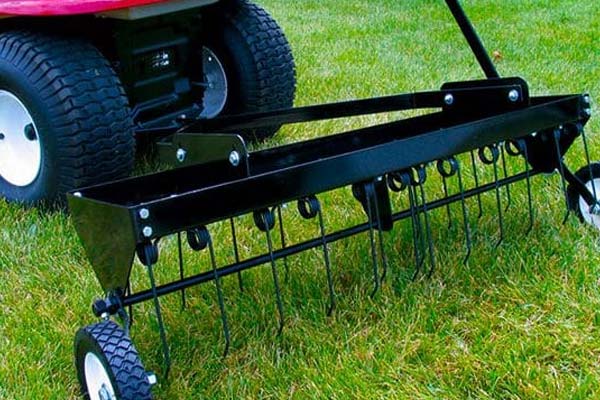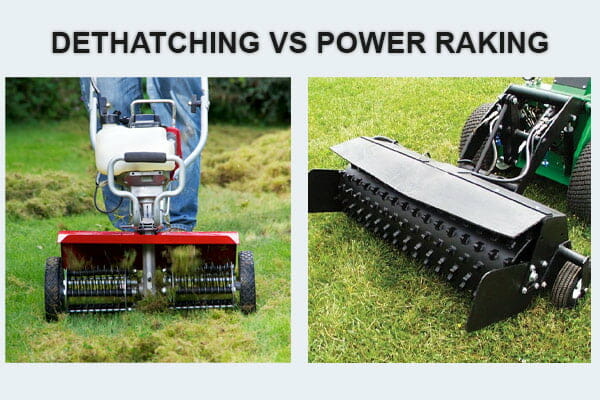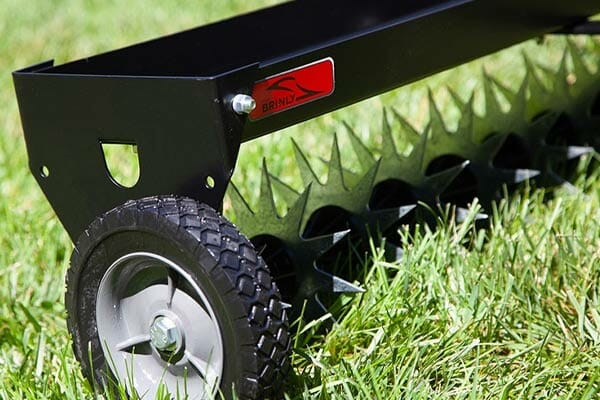Maintaining a beautiful and healthy lawn requires regular dethatching as it allows water and fertilizer to penetrate the ground instead of accumulating excess thatch. Schedule dethatching as one of your essential maintenance tasks by following this link to learn about the benefits: https://homegardenguides.com/lawn/what-is-lawn-dethatching/
The average price for dethatching a standard residential lawn ranges between $120 to $240. Prices are fairly standard however will vary depending on the size of your lawn and the city you live in.
We look at the difference between dethatching and power raking, plus the difference in price between pro services and DIY.
What we cover
ToggleAverage Price for Dethatching
| Lawn Size/ dethatching Pricing | Estimated Price |
|---|---|
| The average price for dethatching | $120 - $250 |
| Lawn dethatching per square foot | $0.012 - $0.025 |
| Lawn dethatching per hour | $55 - $65 |
| Dethatching price per ½ acre | $252 - $520 |
| Dethatching per 1 acre | $500 - $1000 |
Lawn Dethatching Per Square Foot
Expect to pay amounts in the region of $0.012 per to $0.025 per square foot. This translates to $125 to $250 for every 1000 square feet of lawn.
As you can probably guess from the cost estimates above, the amount you end up paying per square foot comes down to very specific aspects of the job such as topography, thatch density, etc. It’s best to have either have a pro come over and inspect the lawn or send as much information to landscaping companies bidding for the job to get a fair quote.

Lawn Dethatching Per Hour
Lawn dethatching services can also be offered on hourly rates with the average rate ranging between $50 to $65 in most states. Hourly rates are risky for homeowners we the longer it takes the workers the more it costs. I do suggest you get a firm estimate before they start, instead of an hourly rate.
Be sure to discuss this with the landscaping or lawn dethatching company before they prepare their quote or before you start receiving bids. Make it clear that you are either looking for an hourly quote based on the lawn size or one based on square feet (surface area).
Dethatching Price Per ½ Acre
Dethatching a fairly flat ½ acre lawn with no special requirement costs between $252 to $520 in the United States. Bigger lawns could take much longer to dethatch and may have other elements that drive the price up so have the contractor check the lawn out before signing a contract.
Dethatching Per 1 Acre
Dethatching a 1-acre lawn could cost anything between $500 to $1000 depending on the condition of the grass, how long it takes to dethatch, and other factors. 1-acre lawns are quite large and might require more specialized equipment and additional services such as hydroseeding to restore good health.
Factors that Add to Cost of Dethatching
Lawn dethatching costs vary depending on the following factors:
- Lawn size
- Type and amount of thatch
- City you live
- Topography of lawn
- Additional services
Lawn Size
How big is your lawn in terms of surface area? Small lawns below 1000 square feet can be dethatched quickly and the debris raked away while larger lawns above 10,000 feet will take an hour or more. This of course has a direct bearing on the amount you will pay to the landscaping company as they will spend more time and resources working on your lawn.
Generally, small residential lawns require at least 15 minutes to dethatch, standard lawns of about 10,000 square feet require at least an hour to dethatch while oversized lawns above 10,000 require three to four hours to complete. Of course, the amount of time spent dethatching a lawn also depends on the number of workers on-site, the machinery or equipment used, and other factors.
Type and Size of Thatch
A lawn with a mixture of dead weed, over an inch long of dead grass stems and compacted soil will require more effort and heavy raking or dethatching machinery. This has a direct effect on the amount of time spent by the contractor to complete the job meaning higher costs. Most landscaping companies will want to do a physical tour and see the amount of thatch to be worked on before they offer a final quote.
Dethatching equipment In Use
Some dethatching jobs can be completed with a simple rake while others need more expensive mechanical equipment such as dethatching machines or power rakes that can bore into the dead grass. These machines are mostly diesel or electrically powered and will drive the costs higher than simple tools.
Just as a comparison, hiring a vertical machine or purpose-built dethatcher for a day of DIY dethatching costs between $40 to $50 for two hours while you could use the simple hand rake you have lying in your shed for a simple dethatching job. You may also need to rent both the vertical machine and lawn vacuum.
Most contractors also come with a lawn vacuum to help with clearing the debris from the cleared thatch so that you can make easy work of restoring your lawn to good health immediately after dethatching. All these machines will cost money to run and the contractor will factor that into their quote.
Lawn Topography and Condition
Generally, flat lawns with little to no obstacles make the dethatching job easy for the landscaping company and will cost less as compared to lawns with steep slopes, uneven patches, and lots of obstacles such as shade trees, walkways, and other land features. It’s generally harder to dethatch a lawn with steep slopes or anthill mounds, obstacles because the powered vertical machines need to be stopped and reconfigured in the middle of the job.
Weather Conditions
It’s not recommended to dethatch a lawn during the rainy or winter season because the machine will end up removing a lot of the healthy grass beneath the grass. However, job-specific conditions, especially for lawns on commercial property may sometimes require that the dethatching is done at any time. Dethatching a lawn in the hot summer sun or a day or two after torrential rains is more complex and may take more time to complete which will affect the costs.
Additional Services
Most landscaping companies will suggest that you do some seeding or aeration immediately after dethatching the lawn to ensure that it stays healthy. This is because dethatching prepares the lawn for better germination and aerating at this point would have the best outcome. These additional services will come with a fee and need to be factored into your budget. Keep in mind that poor aeration also contributes to thatch buildup.
At the same time, you may also need to cater for essential activities such as lawn vacuuming and thatch disposal that are not part of the dethatching job for some contractors. You can offer to do the clean up with a rake after the contractor is done with dethatching to reduce costs. Use the thatch to create mulch or composite for other gardening jobs on your property if possible.
Number of Workers Onsite
The numbers of workers on site will have a direct effect on the total amount you might end up paying for the dethatching job mostly if you signed an hourly contract. In most cases, a three-member crew is enough to finish the job although more might be needed if there is additional equipment being used to clean up or plant seed after dethatching. The landscaping company will give a quote based on the number of workers and how much time they spend working on your lawn.
What Is Lawn Dethatching?

Lawn dethatching is the process of removing dead organic material (thatch) that has accumulated over a period of time. It can be done using a normal rake or using power equipment that cuts through the thatch and uproots any dead plant matter that may be present in the grass.
Some weeds, leaf stems, and roots often take a long time to fully decompose into the soil especially in hot seasons. This usually makes your lawn look brown or appear like it’s drying out even when you have a water sprinkler system in place. The dried up but non-decomposing weed and grass stems are what is referred to as thatch and will prevent new grass to grow if it is not removed.
Lawn dethatching is mainly done to encourage healthy grass to germinate and grow as it will be able to receive more sun, water, and nutrients. Lawn dethatching is often followed by seeding although it may not be necessary for all lawns.
What Does Dethatching Do for Grass?
Dethatching gets rid of excessive thatch that is above half an inch in length and dead non-decomposing weeds, grass stems, and other debris. By removing the thatch, healthy grass will have an opportunity to grow because it can access more nutrients from your fertilizer, more water, and more sun. Dethatched grass is also generally more comfortable to walk on even with bare feet and safer for pets and small children to run on.
Dethatching also has some additional benefits to your grass, among them:
Prevents fungi and disease- Too much thatch is bad news for most lawns because it causes fungi and insect buildup that could be a threat to your pets and loved ones. Mosquitoes and other dangerous animals and insects find it comfortable to hide in thick thatched grass and build their nests or lay eggs, especially during cold weather. At the same time, too much thatch acts as a magnet for the humidity that is also not good for comfort and health.
It allows new grass to germinate- Dethatching has more or less the same effects as aeration although you still need to aerate if you are dealing with compacted or dry soil. By removing excess thatch and other debris, new healthier grass will sprout because it has more access to water and other essential nutrients.
Allows for better thatch formation- not all thatch is bad. Thatch that is less than half an inch thick is essential for your lawn because it prevents water loss, prevents soil compaction by cushioning the soil, and is generally more comfortable to walk. By getting rid of dead grass and thick thatch you will allow new healthier growth that can be managed with a lawnmower to grow in its place.
Enhances Lawn beauty- There is nothing more annoying than a lawn with thick strands of thatch and brown grass that is uncomfortable to walk on. Dethatching allows for new grass to grow and generally makes your lawn look more even on the surface thus making it more beautiful to look at.
Dethatching Vs Power Raking

A power rake is one of the equipment you might choose to detach your lawn if you do not have access to a purpose-built dethatcher or vertical machine. Power raking uses a mechanically driven rake to remove excess thatch that is over a half-an-inch in thickness. It’s preferred where there are too much thatch and debris to be cleared up because it can dig deeper into the grass and are more aggressive.
A dethatcher is more appropriate for simpler jobs and is generally easier to operate than a power rake. It uses steel spring tines that can dig into the grass and uproot thatch. In most cases, dethatchers are preferred to power rakes unless there is excess thatch to be removed in cases where a lawn has been left unattended for more than a year.
Power rakes are heavy machines that are normally used for commercial dethatching. It’s not common to find them in homes or with small landscaping companies although they can be hired if they are needed for a specific job. They are also preferred for large lawns above an acre because they can clear more thatch within a short period as compared to normal dethatching machines.
How Often Do You Need To Detach A Lawn?

Lawn dethatching should be done when there is clear evidence of thatch that needs to be removed. It’s easy to see that your lawn needs dethatching through visual inspection. That said, it is recommended to dethatch your lawn at least once a year, immediately after the growing season. You can also choose to dethatch in the summer when there is a lot of dead grass and weeds so that you can hydroseed immediately after but this will require that you use an artificial water sprinkler system to encourage sprouting and grass health in the hot summer sun.
Your lawns need urgent dethatching if you observe the following signs:
- Long blades of thick, dense grass and weeds that are over an inch thick.
- Dry spots across the lawns
- Too much humidity retained in the grass
- Diseased grass
- An increase in the number of insects living in the grass -especially flying insects such as mosquitoes
- Grass forms footprints that don’t disappear immediately
- Visible dried but non-decomposing organic matter such as weed stems and dried grass(some grass and plant stem take a long time to decompose due to an anti-decaying enzyme called lignin.
Can Dethatching Hurt Your Lawn?
Dethatching is safe and has far-reaching benefits to your lawn as discussed earlier. However, you should make sure that the whole exercise is done properly and that the right equipment, in the right setting, is used otherwise you may cause more harm than good to an otherwise healthy lawn.
For instance, you should the vertical or dethatching machine is set to the right combing depth to avoid removing healthy sprouting grass blades. You should also avoid dethatching immediately after it rains as this might also cause the machine to remove too much grass than needed. Lastly, ensure that the removed thatch is raked away in good time to allow the healthy grass to absorb the sun and water otherwise it might yellow out and die.
Does Dethatching Remove Weeds?
Weeds usually contribute to excess thatch buildup and will be removed by the power rake or dethatching machine. That said, you should also use other weed removal methods and not rely on dethatching alone as doing so wouldn’t solve the weed problem entirely due to weed seeds and root systems that may remain intact in the soil after dethatching. Use a weed killer a week or two before dethatching to make the work easier for the dethatcher.
FAQ's
Is dethatching necessary?
Yes, dethatching is a necessary lawn care activity because it keeps your lawn healthy and young throughout all seasons. Failure to dethatch at least once every year would mean that you will have to have the grass removed and replanted because of too much old thatch that usually appears brown and tends to harbor insects and diseases.
Should I dethatch or aerate first?
Aeration is done to make the soil less compact and allow water and fertilizer to seep into the loosened soil. You cannot aerate properly if there is too much thick thatch so you should dethatch first before you aerate and water your lawn. Ideally, you should also hydroseed or plant regular seeds after aeration.
Should I fertilize after dethatching?
The lawn condition after proper dethatching and aeration is perfect for the fertilizer to seep into the soil and promote grass growth. You should, therefore, have some fertilizer ready to apply after dethatching so that you can maintain the growth that is bound to increase after dethatching.
How do you get rid of thatch naturally?
Regular dethatching is the surest method you can use to get rid of thatch. However, you can also use other natural techniques to reduce thatch such as keeping the soil under the thatch moist for long periods to aid decomposition, using worms to eat dead grass stems and weeds, etc. Proper lawn care through routine mowing, watering, aeration, and replanting might also prevent excess thatch formation.
Should I rake after dethatching?
You must rake and dispose of the removed thatch after dethatching. Leaving it lying on the lawn will cause yellowing as the young grass will not be able to access the sun or water. You can use a lawn vacuum to make the work easier if you are working on a large lawn.
Can you dethatch too much?
Dethatching should be done with the right equipment in the right setting to prevent causing too much damage to young and healthy grass. For instance, thin thatch may be destroyed by a power rake due to its cutting depth so it should be avoided.
Is raking the same as dethatching?
It is possible to use a rake to dethatch although it may take a lot of time and not give the best results. It’s recommended to use a power rake for thick thatch and a detaching machine or vertical for thin thatch.
When is the best time of year to dethatch?
Dethatching should be done during or after the growing season for the type of grass you have on your lawn. It can be done during or after spring and later in summer.













